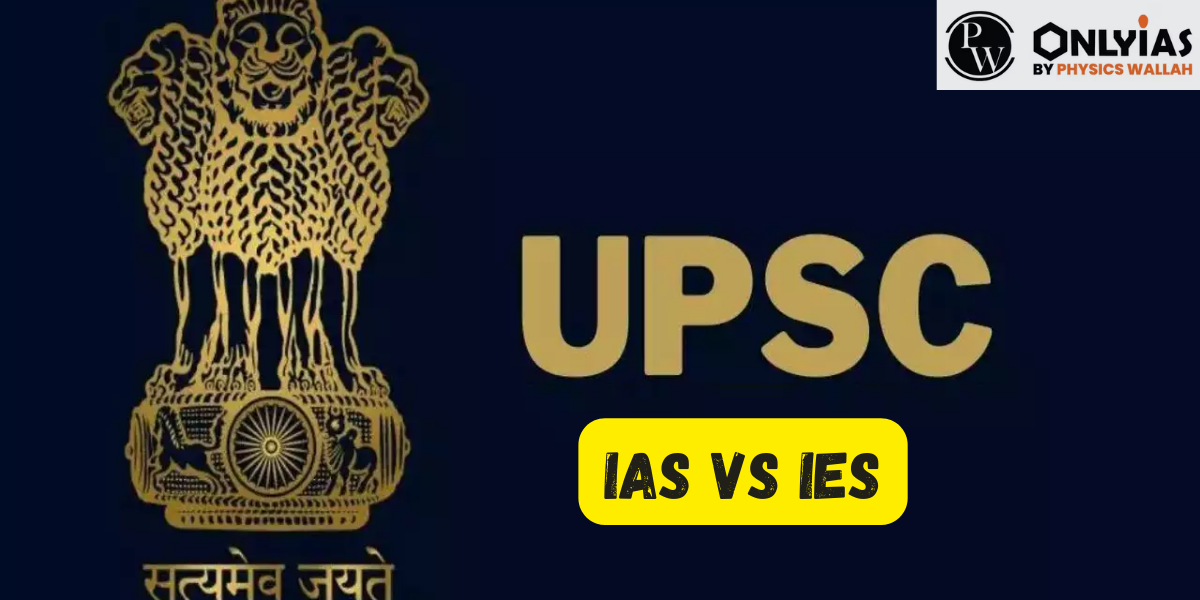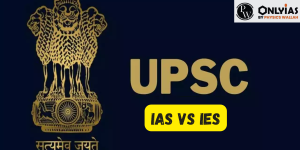![]() Madhavi Gaur
Madhavi Gaur
![]() August 18, 2023 07:16
August 18, 2023 07:16
![]() 5331
5331
![]() 0
0

In the realm of the Union Government, two prestigious units take center stage – the Indian Administrative Services (IAS) and the Indian Engineering Services (IES). Each acronym represents a distinct career path, with IES denoting Indian Engineering Services and IAS signifying Indian Administrative Services. Both of these coveted positions fall under the purview of the Union Public Service Commission (UPSC), which conducts their respective examinations.
When it comes to prestigious government services in India, the Indian Engineering Services (IES) and the Indian Administrative Services (IAS) stand out as two of the most sought-after career paths. While both offer a platform for individuals to serve the nation and contribute to its growth, they differ significantly in various aspects. In this article, we delve into the distinctions between IES and IAS, shedding light on their roles, eligibility criteria, selection process, and career prospects, allowing aspiring candidates to make an informed choice based on their interests and aspirations.

IES (Indian Engineering Services): The IES is a group ‘A’ government service under the central government, primarily responsible for managing technical and engineering functions in various government departments and organizations. IES officers play a crucial role in the design, implementation, and maintenance of various infrastructure projects and technical systems across the country.
IAS (Indian Administrative Services): On the other hand, the IAS is a premier administrative service in India, serving as the backbone of the country’s administrative machinery. IAS officers are responsible for policy formulation, implementation, and governance at both the central and state levels. Their roles encompass diverse areas, ranging from law enforcement and revenue administration to developmental planning and public service delivery.
IES (Indian Engineering Services): To be eligible for the IES examination, candidates should have a degree in engineering from a recognized university or institution. They must also meet specific age requirements and citizenship criteria.
Indian Administrative Services (IAS): The eligibility criteria for the IAS examination include a bachelor’s degree in any discipline from a recognized university. The candidate’s age and nationality also play a role in determining eligibility.
Indian Engineering Services (IES): The selection process for IES involves a written examination followed by an interview. The written examination consists of multiple stages, including objective and conventional papers related to engineering disciplines.
Indian Administrative Services (IAS): The IAS selection process includes three stages: Preliminary Examination, Main Examination, and Personality Test (Interview). The Prelims comprise two objective papers, while the Mains consist of nine papers, including essay writing and optional subjects.
Indian Engineering Services (IES): IES officers are primarily involved in technical and engineering roles. They work on designing and implementing projects, conducting inspections, ensuring quality control, and managing technical aspects of government initiatives.
Indian Administrative Services (IAS): IAS officers have a broader scope of work, ranging from administrative and developmental roles to policy formulation and implementation. They work across various sectors, addressing issues such as law and order, revenue administration, healthcare, education, and rural development.
Indian Engineering Services (IES): IES officers have a clear career progression within the technical and engineering domain. They can advance to higher positions, such as Chief Engineer or Director General, based on their experience and performance.
Indian Administrative Services (IAS): IAS officers have a diverse and dynamic career path. They can serve in different departments, assume key positions at district and state levels, and eventually move to top administrative positions at the central government, such as Secretary or Cabinet Secretary.
At the heart of the distinction lies the scope of roles and responsibilities assumed by IAS and IES officers within the Indian Government. IAS officers are entrusted with positions in the administrative and managerial divisions, contributing to the effective governance, policy formulation, and execution of government initiatives. On the other hand, IES officials are tasked with a specialized role, engaging in the executive and technical aspects that underpin the functioning of the government.
Before delving into the intricate differences between IAS and IES, it’s essential to understand each cadre independently, grasping the essence of their contributions to the nation.
Indian Administrative Services (IAS): The IAS serves as the premier administrative arm of the Indian Government. IAS officers play a multifaceted role, handling a diverse range of responsibilities that span across various sectors, such as law enforcement, revenue administration, public service delivery, and developmental planning. Their presence is felt at both the central and state levels, where they contribute to policy formulation, implementation, and the overall governance of the nation.
Indian Engineering Services (IES): The IES, on the other hand, is the cornerstone of technical expertise within the government machinery. IES officers are equipped with specialized knowledge in engineering disciplines, allowing them to spearhead critical tasks such as designing, executing, and supervising infrastructure projects, ensuring quality control, and managing technical aspects that drive progress across various government departments.
Now that we have explored the individual domains of IAS and IES, let’s unravel the core distinctions that set these two units apart.
IAS officers are synonymous with administrative and managerial roles, shaping policies, and steering the nation’s course through effective governance.
IES officials, driven by technical acumen, are at the forefront of executing and overseeing vital projects that contribute to the nation’s development and progress.
| Criterion | IAS | IES |
|---|---|---|
| Eligibility | Indian Graduates from any discipline, Age – 21 to 32 | Indian Engineering Graduate, Age – 21 to 30 |
| Exam Structure | Three Stages: Prelims, Mains, Interview | Three Stages: Prelims, Mains, Interview |
| Full Form | Indian Administrative Service | Indian Engineering Service |
| Number of Attempts | 6 (For GEN & EWS) | No Limit |
| Number of Vacancies | 1011 | 247 |
| Profile | Public Administration | Technical Projects |
| Salary | INR 56,100 | INR 55,135 |
| Syllabus Length | Vast | Confined to Engineering Subjects |
The Indian Administrative Service (IAS) serves as the administrative wing of the All-India civil service in India. IAS constitutes one of the three arms of the Union Public Service Commission (UPSC), alongside the Indian Police Service (IPS) and the Indian Foreign Service (IFS).
IAS holds a position of immense prestige due to its involvement in the executive branch, forming the permanent bureaucracy of India. IAS officials occupy pivotal and discretionary roles in both Union and State Governments, as well as in public sector enterprises.
IAS officers undertake various significant responsibilities across diverse government departments. Some of these functions include:
Indian Engineering Services (IES) represent the civil service that addresses India’s technological and administrative functions. Through the IES Examination, the Union Public Service Commission recruits candidates for the technical branch of the government. These civil servants play a pivotal role in overseeing a substantial portion of the country’s public sector economy.
The Indian Engineering Service (IES) examination is highly competitive and offers prestigious positions in both managerial and technical domains.
Some of the duties and roles that an IES officer may undertake are:
The UPSC Civil Services Examination (CSE) and Engineering Services Examination (ESE) are both national-level exams conducted by the Government of India to select candidates for diverse government services. However, there are several factors that distinguish between IAS and IES. Let’s delve into these differences:
IAS To be eligible for IAS, candidates need to hold a bachelor’s degree. Specific specialization is not mandatory; candidates from any discipline can apply. Additionally, candidates pursuing diplomas or correspondence courses are eligible. Aspirants should be Indian citizens and in their final year of education. The age range for IAS applicants is typically between 21 and 32 years.
IES For IES eligibility, candidates must hold a graduation degree in engineering. BTech/BE graduates in their final year of studies are eligible to apply. Postgraduates with relevant subjects in the Science stream, such as Wireless Communication, Electronics, Radio Physics, and Radio Engineering, can also apply for specific posts. The age limit for IES applicants is generally between 21 and 30 years.
IAS IAS recruitment involves clearing the UPSC Civil Service Examination, comprising three stages: Preliminary exam, Mains exam, and Personal Interview. The Preliminary exam includes two objective papers, with Paper 2 being qualifying and Paper 1 determining merit. The Mains exam consists of 9 papers, including two qualifying papers and seven merit-determining papers. Successful candidates proceed to the personal interview stage.
IES IES recruitment entails a written examination and a personal interview. The written examination comprises an objective section covering general studies and a subjective section requiring essay-type responses based on a specific engineering field. Those who qualify proceed to the personal interview stage, and candidates who clear this round are selected for various departments based on merit.
The distinction between IAS and IES is characterized by intense competition on both fronts.
IAS
As previously mentioned, IAS represents one of the most rigorous civil service positions. Every year, approximately nine lakh candidates apply for civil service examinations, with over four lakh candidates advancing to the preliminary stage.
IES
IES, given its technical nature and demanding criteria, is also considered among the most challenging exams. Roughly 2.5 lakh candidates vie for IES exams annually, with only a few hundred ultimately being selected.
Differences between IAS and IES extend to reputation and responsibilities:
IAS
An IAS officer’s role involves closer interaction with the public and authority over law enforcement and judicial proceedings. They also support legislative operations to ensure efficient governmental systems. As an IAS officer ascends to higher positions, such as Cabinet Secretary, they gain the potential to influence political decisions. This designation provides oversight of nearly all major administrative functions.
IES
An IES officer, though able to move across different units, typically operates within technological domains. Consequently, an IES officer’s influence outside their organization remains limited, and they do not wield significant power.
While being a public figure or holding political influence is a noteworthy responsibility, it does not inherently come with the IES role. Beyond their official duties, an IES officer is akin to any other ordinary citizen.
Comparing IAS and IES reveals distinct levels of political involvement for each cadre.
IAS
IAS officers shoulder the responsibility of addressing social issues and administrative tasks, thus wielding substantial power. However, with greater power comes heightened responsibility, and IAS officers are accountable to the legislature. Consequently, political intervention is a part of their role.
IES
In contrast, IES primarily deals with technological matters. While political intervention exists, it is less pronounced than in the case of IAS. IES officials exercise their authority within the framework of the legislature, with comparatively less political influence.
6. Compensation
The salary disparity between IAS and IES is minimal, as their pay scales and additional benefits remain largely similar.
IAS
The 7th Pay Commission governs the pay structure for civil servants. As per its guidelines, the monthly salary for an IAS officer is INR 56,100.
IES
Under the 7th Pay Commission, an IES officer’s monthly salary amounts to INR 55,135.
In conclusion, discerning the difference between IAS and IES hinges on a comprehensive understanding of their respective roles and requirements.
IAS officials oversee general administration, while IES officials engage with technology-driven domains. The IAS path suits individuals dedicated to effecting societal change and those possessing strong leadership skills, making it ideal for administrative services.
On the contrary, IES is tailored for tech-driven individuals aiming to leverage their technical expertise to address the nation’s needs. The choice ultimately rests on an individual’s potential and professional aspirations. Deliberate and thoughtful consideration is crucial before making significant decisions. This comprehensive elucidation of the IAS and IES disparities aims to enhance your insights and broaden your perspectives.
<div class="new-fform">
</div>

Latest Comments